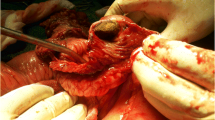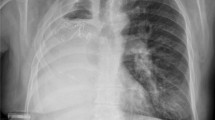Abstract.
Intraperitoneal forgotten foreign bodies are prone to create adhesions and to encapsulate, or to provoke an exudative response, with or without accompanying bacterial infection. Often a process of self-extrusion is initiated. This is also true for gossypibomas, retained surgical sponges. Presentation is possible as a pseudotumoral, occlusive, or septic syndrome; several cases, however, have remained asymptomatic for as long as several decades. Ultrasonography and radiology (especially computed tomography) contribute significantly to the detection of gossypibomas; magnetic resonance imaging is a less used technique. Detection by plain radiography is difficult. Ultrasonography demonstrates a hyperreflective mass with hypoechoic rim and a strong posterior shadow. Computed tomography shows a well defined mass with internal heterogenous densities. Therapy consists of operative removal of the foreign body in association with resolving its complications. Adding a series of five cases to the existing literature reports, the fate of intraperitoneal forgotten surgical sponges is reviewed.
Similar content being viewed by others
Author information
Authors and Affiliations
Rights and permissions
About this article
Cite this article
Lauwers, P., Van Hee, R. Intraperitoneal Gossypibomas: The Need to Count Sponges. World J. Surg. 24, 521–527 (2000). https://doi.org/10.1007/s002689910084
Published:
Issue Date:
DOI: https://doi.org/10.1007/s002689910084




